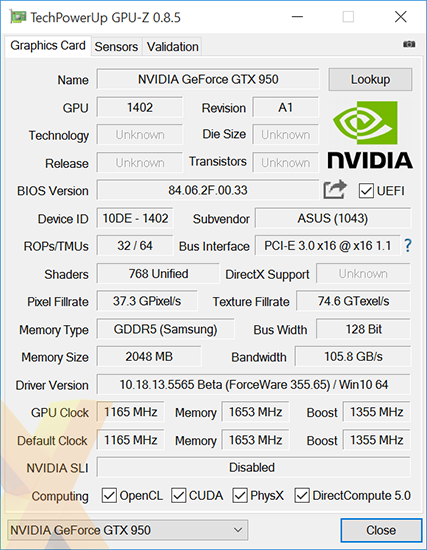Test Methodology
Asus GeForce GTX 950 Strix Direct CU II OC Specification |
|---|
 |
GPU Comparisons |
||||||||
|---|---|---|---|---|---|---|---|---|
| Graphics Card | GPU Cores | Base Clock (MHz) |
Boost Clock (MHz) |
Memory Size (MB) |
Memory Clock (MHz) |
Memory Bus (bits) |
Graphics Driver | |
| Asus GeForce GTX 950 Strix OC | 768 | 1,165 | 1,355 | 2,048 | 6,612 | 128 | 355.65 | |
| Asus GeForce GTX 960 Strix | 1,024 | 1,253 | 1,317 | 2,048 | 7,200 | 128 | 353.62 | |
| Asus GeForce GTX 750 Ti OC | 640 | 1,072 | 1,150 | 2,048 | 5,400 | 128 | 353.62 | |
| Gigabyte GeForce GTX 680 OC | 1,536 | 1,072 | 1,137 | 2,048 | 6,008 | 256 | 353.62 | |
| Sapphire Radeon R7 370 Nitro | 1,024 | 985 | N/A | 4,096 | 5,600 | 256 | 15.7.1 | |
| Sapphire Radeon HD 7970 | 2,048 | 925 | N/A | 3,072 | 5,500 | 384 | 15.7.1 | |
HEXUS Graphics Test Bench |
|||
|---|---|---|---|
| Hardware Components | HEXUS Review | Product Page | |
| Processor | Intel Core i7-4770K (quad-core, overclocked up to 4.40GHz) | June 2013 | Intel.com |
| CPU Cooler | Noctua NH-D15 | April 2014 | Noctua.at |
| Motherboard | Asus Z97-A | May 2014 | Asus.co.uk |
| Memory | 16GB Corsair Vengeance Pro (2x8GB) DDR3 @ 1,866MHz | - | Corsair.com |
| Power Supply | Corsair AX760i | - | Corsair.com |
| Primary Storage Device | Crucial M500 240GB SSD | July 2013 | Crucial.com |
| Secondary Storage Device | SK hynix Canvas SC300 512GB SSD | June 2015 | SKhynix.com |
| Chassis | Corsair Graphite Series 600T | October 2010 | Corsair.com |
| Monitor | Philips Brilliance 4K Ultra HD LED (288P6LJEB/00) | - | Philips.co.uk |
| Operating system | Windows 10 (64-bit) | - | Microsoft.com |
Benchmark Suite |
|
|---|---|
| Synthetic Benchmarks | |
| 3DMark | Fire Strike and Fire Strike Extreme |
| Gaming Benchmarks and Settings | |
| Alien: Isolation | SMAA-T2x, Maximum Quality |
| BioShock Infinite | AA Enabled, Ultra Preset inc. Depth of Field |
| Grand Theft Auto V | FXAA, 16xAF, Very High Quality |
| Middle-earth: Shadow of Mordor | Ultra Quality Preset |
| Tomb Raider | FXAA, Ultra Quality Preset |
| Total War: Rome II | Extreme Preset |
| The Witcher 3: Wild Hunt | High Quality Preset |
| General Benchmarks | |
| Power Consumption | To emulate real-world usage scenarios, we record system-wide mains power draw both when idle and while playing Grand Theft Auto V. |
| Temperature | To emulate real-world usage scenarios, we record GPU core temperature both when idle and while playing Grand Theft Auto V. |
| Noise | A PCE-318 meter is used to record noise levels when idle and while playing Grand Theft Auto V. |
| Overclocking | Maintaining out-the-box voltage, we increase the card's power target and aim for an optimal balance of core and memory overclock. With the heightened frequencies in place, the 3DMark, Grand Theft Auto V and The Witcher 3: Wild Hunt tests are re-run at QHD settings. |
Notes
To minimise the impact of any CPU bottlenecks, our test platform is configured with a quad-core Intel Core i7-4770K processor overclocked at up to 4.4GHz and 16GB of Corsair Vengeance Pro DDR3 memory set to run at 1,866MHz using the built-in XMP profile.
For our midrange benchmark suite, we have an array of games tested at FHD (1,920x1,080) and QHD (2,560x1,440) resolutions. Where applicable, any vendor-specific enhancements such as PhysX and TressFX are disabled to help even the playing field. In-game benchmark results are recorded as minimum and average frames per second.
We have also changed to Windows 10 and completed ground-up testing of six GPUs to put the GeForce GTX 950 into context. Ever more increasingly AMD and Nvidia are seeding the press with partner cards rather than reference samples. This makes sense to a degree, as that's what you buy in the shops, but comparing a number of reference cards to a well-overclocked partner card is not good benchmark practice. Therefore we have benchmarked all comparison cards using retail examples in our labs rather than the reference model(s).









